Menominee vs Shoshone Community Comparison
COMPARE
Menominee
Shoshone
Social Comparison
Social Comparison
Menominee
Shoshone
3,175
SOCIAL INDEX
29.3/ 100
SOCIAL RATING
229th/ 347
SOCIAL RANK
2,256
SOCIAL INDEX
20.1/ 100
SOCIAL RATING
264th/ 347
SOCIAL RANK
Shoshone Integration in Menominee Communities
The statistical analysis conducted on geographies consisting of 25,034,865 people shows a slight negative correlation between the proportion of Shoshone within Menominee communities in the United States with a correlation coefficient (R) of -0.063. On average, for every 1% (one percent) increase in Menominee within a typical geography, there is a decrease of 0.000% in Shoshone. To illustrate, in a geography comprising of 100,000 individuals, a rise of 1,000 Menominee corresponds to a decrease of 0.2 Shoshone.
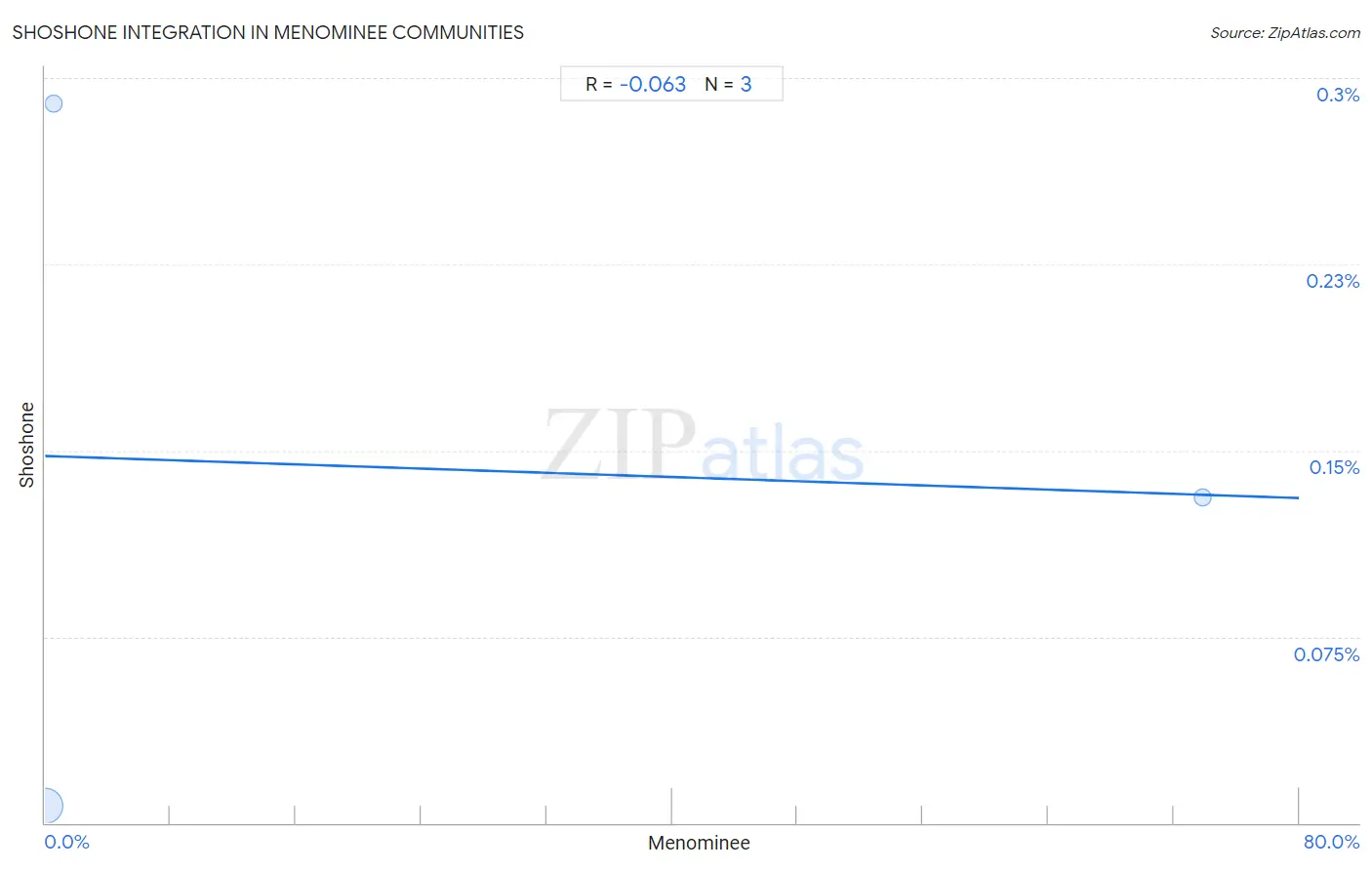
Menominee vs Shoshone Income
When considering income, the most significant differences between Menominee and Shoshone communities in the United States are seen in median male earnings ($42,581 compared to $47,930, a difference of 12.6%), wage/income gap (22.7% compared to 25.4%, a difference of 12.0%), and median family income ($79,563 compared to $87,872, a difference of 10.4%). Conversely, both communities are more comparable in terms of householder income under 25 years ($47,907 compared to $48,720, a difference of 1.7%), median female earnings ($33,894 compared to $34,677, a difference of 2.3%), and householder income ages 25 - 44 years ($79,358 compared to $82,062, a difference of 3.4%).

| Income Metric | Menominee | Shoshone |
| Per Capita Income | Tragic $34,578 | Tragic $37,072 |
| Median Family Income | Tragic $79,563 | Tragic $87,872 |
| Median Household Income | Tragic $68,423 | Tragic $72,660 |
| Median Earnings | Tragic $37,884 | Tragic $40,932 |
| Median Male Earnings | Tragic $42,581 | Tragic $47,930 |
| Median Female Earnings | Tragic $33,894 | Tragic $34,677 |
| Householder Age | Under 25 years | Tragic $47,907 | Tragic $48,720 |
| Householder Age | 25 - 44 years | Tragic $79,358 | Tragic $82,062 |
| Householder Age | 45 - 64 years | Tragic $76,903 | Tragic $83,588 |
| Householder Age | Over 65 years | Tragic $51,719 | Tragic $53,681 |
| Wage/Income Gap | Exceptional 22.7% | Good 25.4% |
Menominee vs Shoshone Poverty
When considering poverty, the most significant differences between Menominee and Shoshone communities in the United States are seen in receiving food stamps (17.2% compared to 12.4%, a difference of 39.0%), single father poverty (16.8% compared to 22.9%, a difference of 36.6%), and child poverty among girls under 16 (25.0% compared to 18.9%, a difference of 32.7%). Conversely, both communities are more comparable in terms of female poverty among 18-24 year olds (22.5% compared to 22.5%, a difference of 0.11%), single male poverty (17.7% compared to 16.7%, a difference of 6.3%), and female poverty among 25-34 year olds (18.0% compared to 16.2%, a difference of 10.7%).
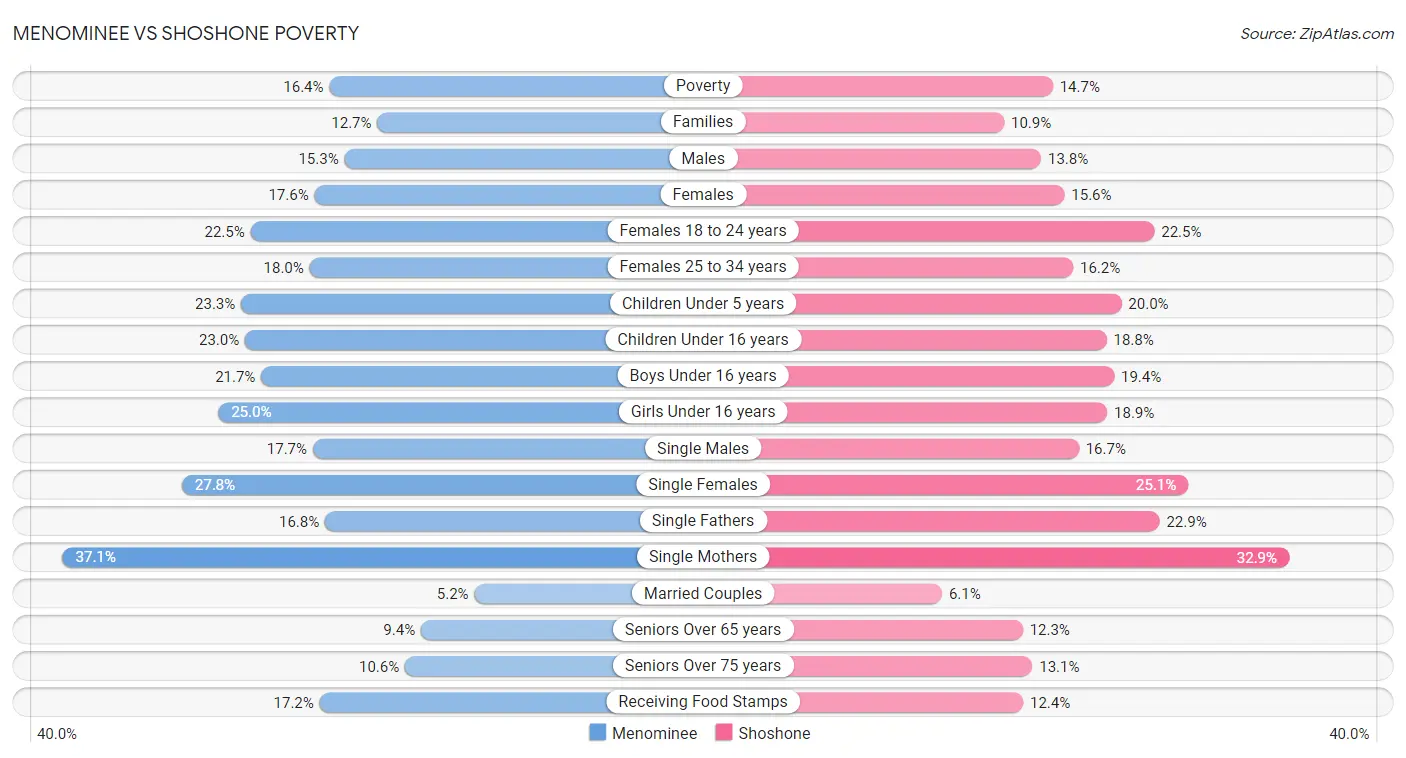
| Poverty Metric | Menominee | Shoshone |
| Poverty | Tragic 16.4% | Tragic 14.7% |
| Families | Tragic 12.7% | Tragic 10.9% |
| Males | Tragic 15.3% | Tragic 13.8% |
| Females | Tragic 17.6% | Tragic 15.6% |
| Females 18 to 24 years | Tragic 22.5% | Tragic 22.5% |
| Females 25 to 34 years | Tragic 18.0% | Tragic 16.2% |
| Children Under 5 years | Tragic 23.3% | Tragic 20.0% |
| Children Under 16 years | Tragic 23.0% | Tragic 18.8% |
| Boys Under 16 years | Tragic 21.7% | Tragic 19.4% |
| Girls Under 16 years | Tragic 25.0% | Tragic 18.9% |
| Single Males | Tragic 17.7% | Tragic 16.7% |
| Single Females | Tragic 27.8% | Tragic 25.1% |
| Single Fathers | Tragic 16.8% | Tragic 22.9% |
| Single Mothers | Tragic 37.1% | Tragic 32.9% |
| Married Couples | Average 5.2% | Tragic 6.1% |
| Seniors Over 65 years | Exceptional 9.4% | Tragic 12.3% |
| Seniors Over 75 years | Exceptional 10.6% | Tragic 13.1% |
| Receiving Food Stamps | Tragic 17.2% | Poor 12.4% |
Menominee vs Shoshone Unemployment
When considering unemployment, the most significant differences between Menominee and Shoshone communities in the United States are seen in unemployment among women with children under 6 years (8.7% compared to 13.2%, a difference of 51.3%), unemployment among ages 55 to 59 years (10.5% compared to 7.4%, a difference of 43.0%), and unemployment among ages 20 to 24 years (9.7% compared to 12.7%, a difference of 31.1%). Conversely, both communities are more comparable in terms of unemployment among ages 35 to 44 years (6.5% compared to 6.6%, a difference of 1.2%), unemployment (6.4% compared to 6.8%, a difference of 5.3%), and unemployment among ages 45 to 54 years (5.3% compared to 5.6%, a difference of 5.6%).
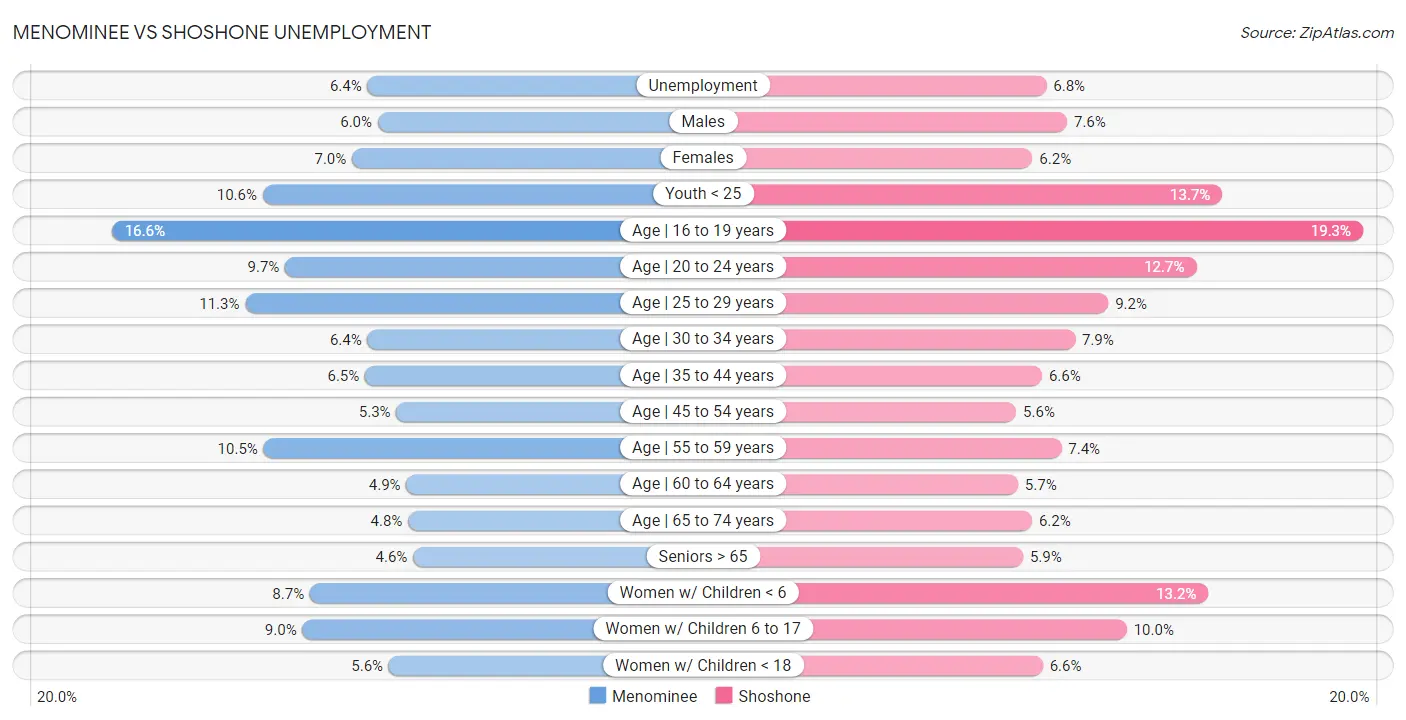
| Unemployment Metric | Menominee | Shoshone |
| Unemployment | Tragic 6.4% | Tragic 6.8% |
| Males | Tragic 6.0% | Tragic 7.6% |
| Females | Tragic 7.0% | Tragic 6.2% |
| Youth < 25 | Exceptional 10.6% | Tragic 13.7% |
| Age | 16 to 19 years | Exceptional 16.6% | Tragic 19.3% |
| Age | 20 to 24 years | Exceptional 9.7% | Tragic 12.7% |
| Age | 25 to 29 years | Tragic 11.3% | Tragic 9.2% |
| Age | 30 to 34 years | Tragic 6.4% | Tragic 7.9% |
| Age | 35 to 44 years | Tragic 6.5% | Tragic 6.6% |
| Age | 45 to 54 years | Tragic 5.3% | Tragic 5.6% |
| Age | 55 to 59 years | Tragic 10.5% | Tragic 7.4% |
| Age | 60 to 64 years | Fair 4.9% | Tragic 5.7% |
| Age | 65 to 74 years | Exceptional 4.8% | Tragic 6.2% |
| Seniors > 65 | Exceptional 4.6% | Tragic 5.9% |
| Women w/ Children < 6 | Tragic 8.7% | Tragic 13.2% |
| Women w/ Children 6 to 17 | Fair 9.0% | Tragic 10.0% |
| Women w/ Children < 18 | Poor 5.6% | Tragic 6.6% |
Menominee vs Shoshone Labor Participation
When considering labor participation, the most significant differences between Menominee and Shoshone communities in the United States are seen in in labor force | age 16-19 (33.9% compared to 39.3%, a difference of 16.0%), in labor force | age 20-24 (68.7% compared to 76.1%, a difference of 10.8%), and in labor force | age 25-29 (85.4% compared to 81.6%, a difference of 4.6%). Conversely, both communities are more comparable in terms of in labor force | age 30-34 (82.2% compared to 81.4%, a difference of 0.95%), in labor force | age 20-64 (75.3% compared to 76.8%, a difference of 1.9%), and in labor force | age 45-54 (77.4% compared to 79.3%, a difference of 2.4%).

| Labor Participation Metric | Menominee | Shoshone |
| In Labor Force | Age > 16 | Tragic 60.6% | Tragic 63.2% |
| In Labor Force | Age 20-64 | Tragic 75.3% | Tragic 76.8% |
| In Labor Force | Age 16-19 | Tragic 33.9% | Exceptional 39.3% |
| In Labor Force | Age 20-24 | Tragic 68.7% | Exceptional 76.1% |
| In Labor Force | Age 25-29 | Exceptional 85.4% | Tragic 81.6% |
| In Labor Force | Age 30-34 | Tragic 82.2% | Tragic 81.4% |
| In Labor Force | Age 35-44 | Tragic 79.7% | Tragic 82.2% |
| In Labor Force | Age 45-54 | Tragic 77.4% | Tragic 79.3% |
Menominee vs Shoshone Family Structure
When considering family structure, the most significant differences between Menominee and Shoshone communities in the United States are seen in single father households (4.2% compared to 2.6%, a difference of 60.8%), births to unmarried women (51.1% compared to 35.3%, a difference of 44.8%), and single mother households (9.2% compared to 6.8%, a difference of 34.8%). Conversely, both communities are more comparable in terms of average family size (3.30 compared to 3.37, a difference of 2.1%), currently married (42.3% compared to 44.0%, a difference of 4.0%), and family households with children (27.6% compared to 26.5%, a difference of 4.2%).

| Family Structure Metric | Menominee | Shoshone |
| Family Households | Exceptional 66.5% | Tragic 63.8% |
| Family Households with Children | Good 27.6% | Tragic 26.5% |
| Married-couple Households | Tragic 42.0% | Tragic 43.9% |
| Average Family Size | Exceptional 3.30 | Exceptional 3.37 |
| Single Father Households | Tragic 4.2% | Tragic 2.6% |
| Single Mother Households | Tragic 9.2% | Tragic 6.8% |
| Currently Married | Tragic 42.3% | Tragic 44.0% |
| Divorced or Separated | Exceptional 11.8% | Tragic 14.0% |
| Births to Unmarried Women | Tragic 51.1% | Tragic 35.3% |
Menominee vs Shoshone Vehicle Availability
When considering vehicle availability, the most significant differences between Menominee and Shoshone communities in the United States are seen in 4 or more vehicles in household (5.0% compared to 8.8%, a difference of 77.8%), 3 or more vehicles in household (17.2% compared to 24.9%, a difference of 45.0%), and no vehicles in household (11.8% compared to 10.8%, a difference of 9.0%). Conversely, both communities are more comparable in terms of 1 or more vehicles in household (88.3% compared to 89.5%, a difference of 1.4%), 2 or more vehicles in household (55.3% compared to 57.9%, a difference of 4.7%), and no vehicles in household (11.8% compared to 10.8%, a difference of 9.0%).

| Vehicle Availability Metric | Menominee | Shoshone |
| No Vehicles Available | Tragic 11.8% | Fair 10.8% |
| 1+ Vehicles Available | Tragic 88.3% | Fair 89.5% |
| 2+ Vehicles Available | Average 55.3% | Exceptional 57.9% |
| 3+ Vehicles Available | Tragic 17.2% | Exceptional 24.9% |
| 4+ Vehicles Available | Tragic 5.0% | Exceptional 8.8% |
Menominee vs Shoshone Education Level
When considering education level, the most significant differences between Menominee and Shoshone communities in the United States are seen in master's degree (10.2% compared to 11.1%, a difference of 8.9%), college, 1 year or more (50.6% compared to 54.3%, a difference of 7.5%), and bachelor's degree (27.3% compared to 29.3%, a difference of 7.2%). Conversely, both communities are more comparable in terms of 7th grade (96.7% compared to 96.6%, a difference of 0.050%), 6th grade (97.5% compared to 97.6%, a difference of 0.10%), and 5th grade (97.7% compared to 97.8%, a difference of 0.12%).
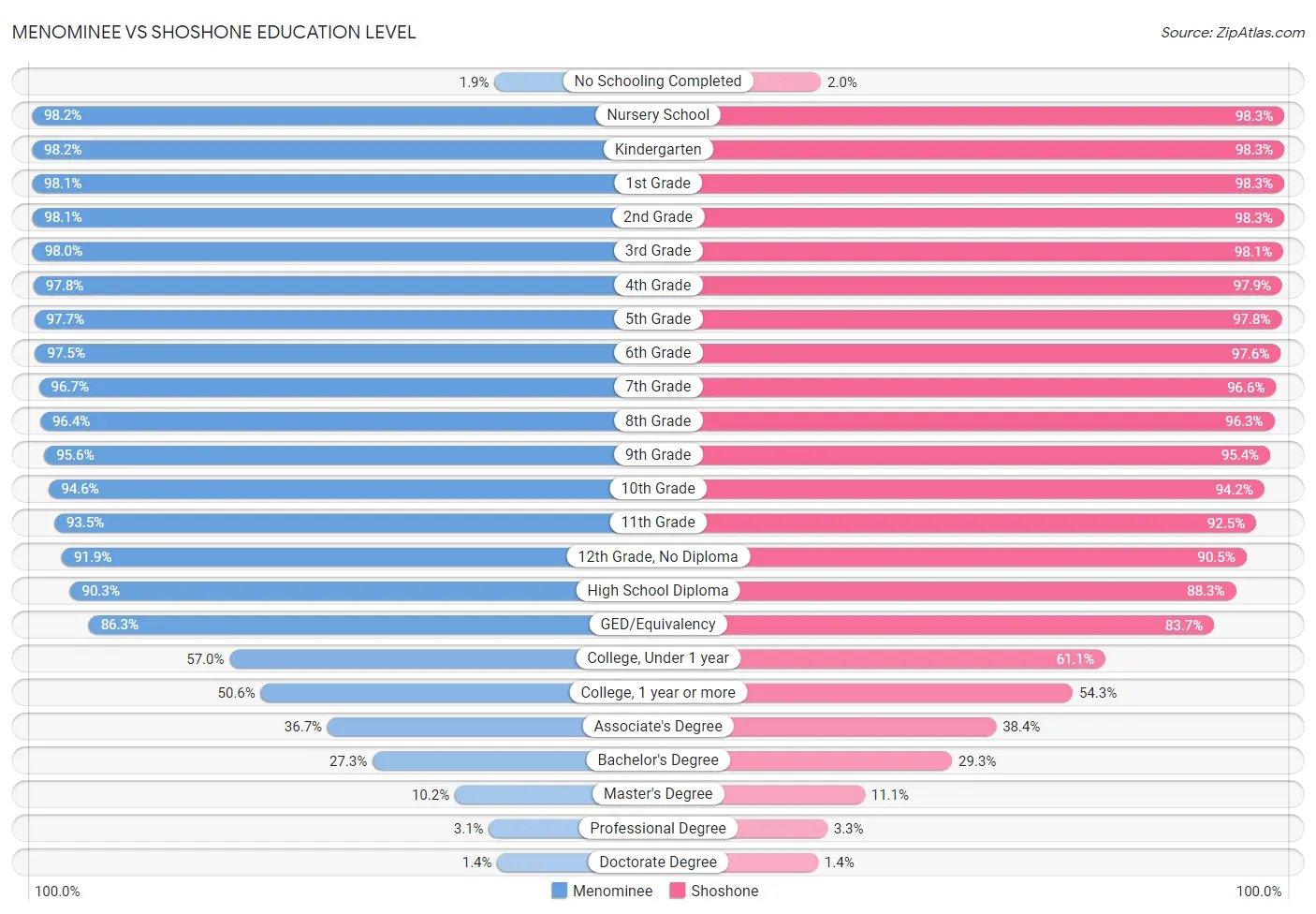
| Education Level Metric | Menominee | Shoshone |
| No Schooling Completed | Excellent 1.9% | Good 2.0% |
| Nursery School | Exceptional 98.2% | Exceptional 98.3% |
| Kindergarten | Exceptional 98.2% | Exceptional 98.3% |
| 1st Grade | Exceptional 98.1% | Exceptional 98.3% |
| 2nd Grade | Exceptional 98.1% | Exceptional 98.3% |
| 3rd Grade | Exceptional 98.0% | Exceptional 98.1% |
| 4th Grade | Exceptional 97.8% | Exceptional 97.9% |
| 5th Grade | Exceptional 97.7% | Exceptional 97.8% |
| 6th Grade | Exceptional 97.5% | Exceptional 97.6% |
| 7th Grade | Exceptional 96.7% | Exceptional 96.6% |
| 8th Grade | Exceptional 96.4% | Exceptional 96.3% |
| 9th Grade | Exceptional 95.6% | Exceptional 95.4% |
| 10th Grade | Exceptional 94.6% | Exceptional 94.2% |
| 11th Grade | Exceptional 93.5% | Average 92.5% |
| 12th Grade, No Diploma | Exceptional 91.9% | Tragic 90.5% |
| High School Diploma | Exceptional 90.3% | Tragic 88.3% |
| GED/Equivalency | Good 86.3% | Tragic 83.7% |
| College, Under 1 year | Tragic 57.0% | Tragic 61.1% |
| College, 1 year or more | Tragic 50.6% | Tragic 54.3% |
| Associate's Degree | Tragic 36.7% | Tragic 38.4% |
| Bachelor's Degree | Tragic 27.3% | Tragic 29.3% |
| Master's Degree | Tragic 10.2% | Tragic 11.1% |
| Professional Degree | Tragic 3.1% | Tragic 3.3% |
| Doctorate Degree | Tragic 1.4% | Tragic 1.4% |
Menominee vs Shoshone Disability
When considering disability, the most significant differences between Menominee and Shoshone communities in the United States are seen in disability age under 5 (2.3% compared to 1.6%, a difference of 41.7%), disability age 35 to 64 (15.9% compared to 14.5%, a difference of 9.9%), and ambulatory disability (7.8% compared to 7.1%, a difference of 9.4%). Conversely, both communities are more comparable in terms of disability age 18 to 34 (7.8% compared to 7.8%, a difference of 0.080%), disability age 65 to 74 (27.4% compared to 27.4%, a difference of 0.23%), and disability (13.8% compared to 13.5%, a difference of 2.0%).
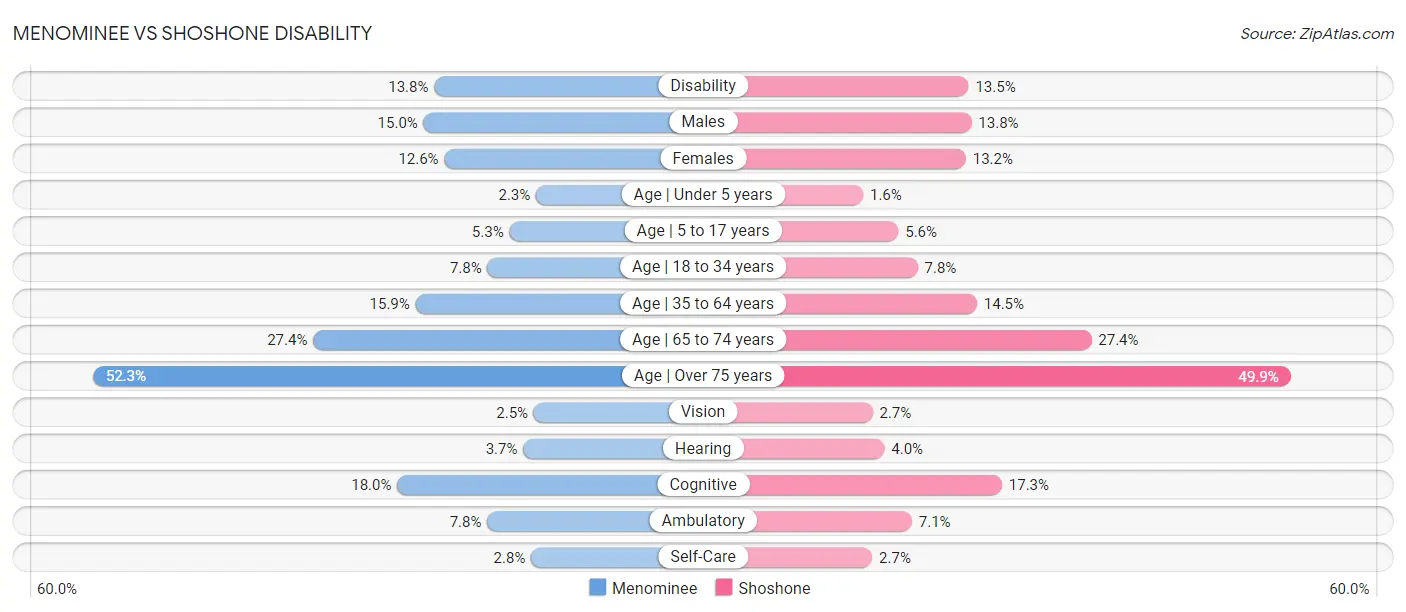
| Disability Metric | Menominee | Shoshone |
| Disability | Tragic 13.8% | Tragic 13.5% |
| Males | Tragic 15.0% | Tragic 13.8% |
| Females | Tragic 12.6% | Tragic 13.2% |
| Age | Under 5 years | Tragic 2.3% | Tragic 1.6% |
| Age | 5 to 17 years | Exceptional 5.3% | Average 5.6% |
| Age | 18 to 34 years | Tragic 7.8% | Tragic 7.8% |
| Age | 35 to 64 years | Tragic 15.9% | Tragic 14.5% |
| Age | 65 to 74 years | Tragic 27.4% | Tragic 27.4% |
| Age | Over 75 years | Tragic 52.3% | Tragic 49.9% |
| Vision | Tragic 2.5% | Tragic 2.7% |
| Hearing | Tragic 3.7% | Tragic 4.0% |
| Cognitive | Tragic 18.0% | Average 17.3% |
| Ambulatory | Tragic 7.8% | Tragic 7.1% |
| Self-Care | Tragic 2.8% | Tragic 2.7% |